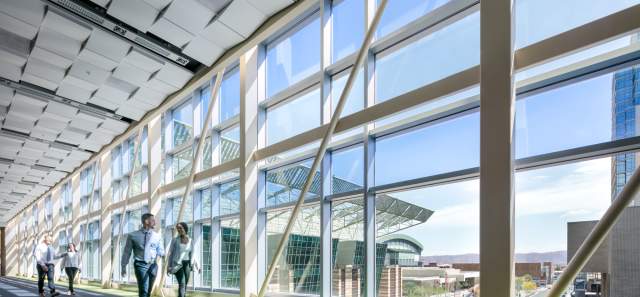Since Phoenix's birth, there have been spaces for the LGBTQ+ community to meet and thrive.
According to Arizona’s Hip Historian Marshall Shore, who has lived in Phoenix since before the city had a "gayborhood,” the region's LGBTQ+ history dates back to First Nation's people and the idea of two spirits.
“Fast forward to the 1950s and George Quaintance, whose art adorned the cover of many of the era's campy muscle magazines," Shore shares. "He did a lot of paintings of half-naked cowboys at his Rancho Siesta, right here in Phoenix.”
Over the years, however, much of the community's early history has been erased. Nonetheless, there are still many places to celebrate (even if they have changed a bit since their heyday). Here's where you can find some of Phoenix's LGBTQ+ history today.
The Melrose District
These days, everyone knows what a gayborhood is and where to find one — even in Phoenix. The Melrose District, a one-mile stretch of Seventh Avenue between Indian School and Camelback roads, is home to a mix of high-rise apartments, almost-historic homes, coffee joints, restaurants, antique/vintage shops, various retail outlets, the highest concentration of LGBTQ+ bars in the state (and likely beyond) — and that all combines for a whole lot of history. What distinguishes this gayborhood is the iconic Melrose Arch, one of Phoenix's two rainbow crosswalks, a larger-than-life rainbow mural on the side of Stacy's @ Melrose (don't miss this photo op), its annual street fair and, of course, the welcoming atmosphere.
Rainbow Crosswalks
In July 2018, two Rainbow crosswalks made the Phoenix landscape a little more colorful. At the request of three of Greater Phoenix's largest LGBTQ+ nonprofit organizations, the Phoenix City Council unanimously approved these installations. The crosswalks are located at the intersections of Central and First avenues at Portland Street (in downtown) and Seventh Avenue at Glenrosa (in the Melrose District).
The Rosson House at Heritage Square
The Rosson House Museum is a fully-restored 1895 Queen Anne Victorian house that offers visitors a glimpse into the lifestyles of early Phoenix families (through guided tours). The house is located in Heritage Square, which is also the site of Phoenix Pride's annual Rainbows Festival. On Oct. 17, 2014, U.S. District Court Judge John Sedwick ruled Arizona's marriage ban unconstitutional. Effective immediately, same-sex couples filed into courthouses and churches to legally tie the knot. And, throughout the weekend that followed, hundreds of couples exchanged vows at the Rosson House and Heritage Square as part of the Rainbows Festival celebration.
Corona Ranch and Rodeo Grounds
Corona Ranch and Rodeo Grounds was home to Arizona's first gay rodeo in 1984, and at the time, Arizona was only the fifth state to host an event of this kind. The Arizona Gay Rodeo Association, which was one of the founding members of the International Gay Rodeo Association, is still going strong 30-plus years later. These days, the rodeo takes place on Valentine's Day weekend and promises pie eating contests, drag shows, vendors, and cowboys as far as the eye can see. Corona Ranch and Rodeo Grounds also hosted the first-ever Latino Pride Festival in 2018.
7611 S. 29th Ave., Laveen Village
Charlie’s Phoenix
At the same time the Arizona Gay Rodeo began, John King and Kenny Cunitz opened Charlie's Phoenix, a country-themed gay bar in Phoenix's Melrose District. The nightclub is still one of Phoenix's most popular bars to go two-stepping, catch a drag show, or spend Sunday funday on the patio. For a true dose of history, be sure to catch the Pussy LeHoot & Friends Show — Arizona's longest-running drag show — at 7 p.m. on Sundays.
727 W. Camelback Road, Phoenix
Transgender Pride Flag
One lesser-known piece of Phoenix LGBTQ+ history is that the Transgender Pride flag was created here. In 1999, U.S. Navy veteran Monica Helms (pictured above) assembled the white, light blue and light pink stripes as a symbol of solidarity for her community. To commemorate the 20th anniversary of the flag’s creation, she was honored as the grand marshal in the Phoenix Pride Parade in April 2019. In June 2019, Phoenix Mayor Kate Gallego issued a proclamation celebrating this anniversary as the flag flew at city hall.
Steele Indian School Park
Phoenix has a history of hosting gay pride-themed events that predate the Phoenix Pride organization we know today. In June 1977, the city's first gay pride week was organized by the city’s LGBTQ+ community at the time and, in 1981, the first pride parade took to the streets. However, the modern-day festival element moved from Margaret T. Hance Park to Steele Indian School Park in 2003, where it takes place to this day. Additionally, the Phoenix Pride organization will celebrate its 40th anniversary as part of the 2020 festivities, which have been rescheduled for Nov. 7-8.
Central Avenue and Adams Street
In December 1986, Keith Haring visited Phoenix to host a drawing workshop at the Phoenix Art Museum. A drive through downtown prompted his proposal to create a mural. In no time, he teamed up with the art museum, the City of Phoenix (which supplied the paint) and about 60 students from South Mountain High School to leave his mark downtown.
At the time, Hartfield’s Dress Shop sat here; today, it's a small parking lot west of Hanny's. The 125-foot, free-handed mural remained until 1991 (the original contract stated that it was to be displayed for a year and then destroyed).
Watch a video of Keith Haring painting the mural in downtown Phoenix with students from South Mountain High School below:
Central Avenue and Adams Street (south east corner)
Greenwood Memory Lawn Mortuary & Cemetery
This is the final resting place of Nicolai de Raylan, a Russian nobleman who emigrated to the United States in the late 19th century. De Raylan was diagnosed with tuberculosis in 1906, and visited Arizona to receive treatment before passing away. According to Arizona's Hip Historian Marshall Shore, it was discovered upon his death that Nicolai was actually one of the city's early gender pioneers. The story made headlines around the globe, including the front page of the Arizona Republic on Dec. 19, 1906, which read: “A man in life, a woman in death.” As a result, Nicolai was buried in a dress and without a headstone — until the local community, led by Shore, stepped in and purchased a headstone identifying him for future generations and casting a new light on his story. Cronkite News reported on this transgender trailblazer here.
The Coronado Neighborhood
This hip, historic neighborhood near downtown was Phoenix's first and, perhaps only, "gay ghetto." In the 1970s, middle class gay white men began moving to the area and renovated many of the midcentury homes. The neighborhood – which encompasses 7th to 16th streets on the west and east, and Thomas to McDowell roads on the north and south sides – has become a highly sought after area for Phoenix residents, thanks to its beautiful 1920s ranches and 1940s bungalows, as well as popular eateries such as The Coronado PHX.
Casa de Cristo
In 1975, the state legislature introduced a bill to ban same-sex marriage in Arizona. This led to a protest from the LGTBQ+ community, including a marriage between Allen Kather and Wally Conoway by Reverend Paul Brenton of Metropolitan Community Church. Because of the church's support for the community, it was burnt down in 1978. LGBTQ+ activists banded together and pooled funds to build the church in a new location, renaming it Casa de Cristo. The church has been and still is a strong advocate for LGBTQ+ equality today.
Arizona State University Library Bj Bud Memorial Archive
Learn all about LGBTQ+ history at Arizona State University's Bj Bud Archive. The Bj Bud Memorial Archives were collected and assembled by local LGBT activists and the Valley of the Sun Gay and Lesbian Center. The Community Center, established in 1993, provided a safe space for the LGBT community in Phoenix. They sponsored and provided several health services, support groups, and educational programs. Additionally, they started a small library and archive that was accessible to anyone who wanted to learn more about LGBT community and experiences.
On February 14, 1996, a lesbian activist named Harlene "Bj" Bud passed away and the Community Center honored her life by naming the collection after her. In the 1970s, Bj and other LGBT leaders led a grassroots effort to mobilize the community. In 1977, she established Sundays Childe, a LGBT newsletter published in Phoenix that covered local news, anti-LGBT legislation, and information about community events. In 1981, she helped plan the first Phoenix Pride March and Rally. In the late 1980s and early 1990s, she also participated in the Governor Mecham recall and brought awareness to the AIDS crisis in Arizona.
The digital collection contains photographs and periodicals documenting Lesbian, Gay, Bisexual and Transgender (LGBT) history in Arizona from late 1970's to early 2000's.
You Might Also Like
LGBTQ+ Travel
Greater Phoenix’s fusion of natural splendor and metropolitan verve sets it apart from a lot of big…
Celebrate Pride In Phoenix
Find out what to expect during this two-day festival in October, including the Phoenix Pride parade…
Explore Phoenix's Melrose District
This 1-mile stretch of Seventh Avenue is home to the Phoenix's top spots for antiques, art, dining…







